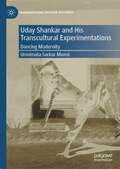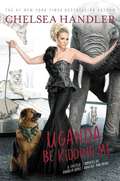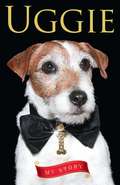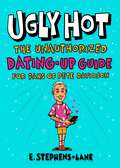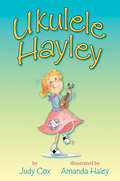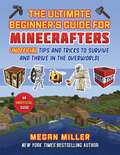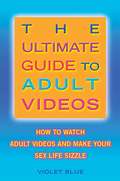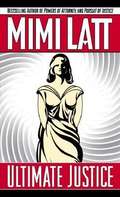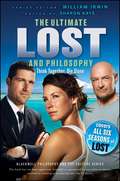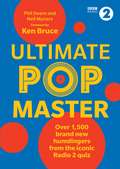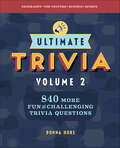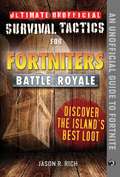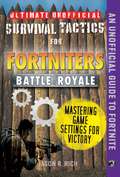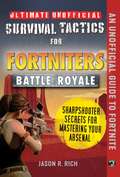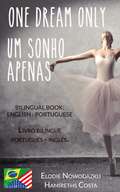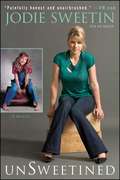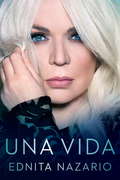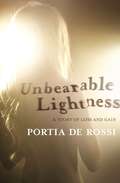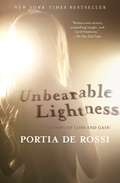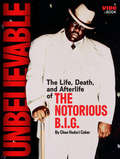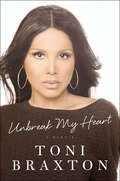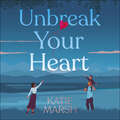- Table View
- List View
Uday Shankar and His Transcultural Experimentations: Dancing Modernity (Transnational Theatre Histories)
by Urmimala Sarkar MunsiThis monograph presents a specific experience of modernity within the context of Indian dance by looking at the transcultural journey of Indian dancer / choreographer Uday Shankar (1900b – 1977d). His popularity in Europe and America as an Oriental male dancer in the first half of the 20th century, and his worldwide recognition as the Ambassador of Indian culture, are brought into a historiographical perspective within the cultural and social reforms of early twentieth century India. By exploring his artistic journey beyond India in the period between the two world wars, and his experience of dance making, presentational technique and representation of India through various phases of his life, a path is forged to understanding the emergence of modernity in Indian dance.
Uganda Be Kidding Me
by Chelsea HandlerThe author who is a stand-up comedian herself, describes her travel adventures and misadventures during a trip to Africa with her friends.
Uggie--My Story: My Story
by UggieA heartwarming memoir by the Jack Russell Terrier that starred in The Artist and Water for Elephants.Uggie&’s memoir offers readers the true rags-to-riches tale of one ordinary Jack Russell Terrier who made it big in Hollywood. For the first time, Uggie tells his story of rising from humble beginnings as an abandoned shelter dog to being adopted by esteemed trainer Omar Von Muller. Uggie details his time starring in commercials for everything from Kia cars to Bud Light. Uggie eventually broke into the film world with his appearance in Mr. Fixit in 2006. He went on to appear in Wassup Rockers and Life is Ruff. Uggie got his first serious film role in 2011's Water for Elephants where he starred alongside Reese Witherspoon and Robert Pattinson. It was not, however, until 2012's The Artist that Uggie really dazzled audiences with his talents. In his memoir, Uggie will talk about life on the set of the Oscar-winning film and the role that many said should have earned him an Oscar. Uggie's memoir doesn't just hit on his career highlights, it also takes a candid look at his his private demons: overcoming a painful past as a cat-murderer and finding redemption; living with shaking syndrome; his regret at never siring any pups before being neutered. Uggie's memoir will include not just biographical information, but also advice from the dog himself. As is seen in his dazzling performance in The Artist, Uggie is an incredibly talented performer. He honed his craft while touring South America each year as part of The Incredible Dog Show, and in his memoir, he will spend several chapters sharing practical training and dieting tips that he has developed over the years.
Ugly Hot: The Unauthorized Dating-Up Guide for Fans of Pete Davidson
by E. Stephens-LaneHow does he do it?We can’t all be drop-dead gorgeous, but we can all be ugly hot! Pete Davidson’s unlikely rise from the depths of his mom’s basement to the upper echelons of fame and straight into the arms of A-listers like Ariana Grande, Kate Beckinsale, Kim Kardashian, and Emily Ratajkowski gives hope to us all. With meticulous analysis, insightful quotes, scientific-ish studies, admittedly irrelevant trivia, and loads of cheeky humor, Ugly Hot: The Unauthorized Dating-Up Guide for Fans of Pete Davidson holds all the secrets to finding love above your station, just like Pete. Follow the magical journey of a Staten Island everyman–turned–Hollywood playboy and collect valuable knowledge along the way, including:- How to exude supreme confidence and give off that BDE!- How to use humor and questionable fashion to your advantage- How to be vulnerable in a way that’s more sexy than annoying- How to low-key seduce someone who seems way out of your leagueWith wisdom gained from observing Pete’s public romances, this guide is designed to give everyone a fighting chance. Because if Pete can win at love, so can you!
Ukulele Hayley
by Judy Cox Amanda HaleyEveryone has a talent, right? Hayley is sure she has one, but she's having trouble pinpointing it. Then Hayley buys a ukulele at a yard sale. Learning to play takes practice, but it's fun, fun, fun. Before long Hayley is strumming up a storm, and her classmates want in on the action. Then terrible new threatens not only the new uke band, but the whole school music program. Now it's up to Hayley and her band to come up with a creative plan to keep their school rocking.
Ultimate Beginner's Guide for Minecrafters: Unofficial Tips and Tricks to Survive and Thrive in the Overworld!
by Megan MillerThe most comprehensive guide available for new players learning the ropes of the world's most popular game—Minecraft! NOT OFFICIAL MINECRAFT PRODUCT. NOT APPROVED BY OR ASSOCIATED WITH MOJANG. Immerse yourself in a new, vibrant, delightful world—exploring, fishing, farming, fighting (if you want), fossil-hunting, and so much more. Unlike any other game world, in Minecraft, you can touch, pick up, and place pretty much anything you see, anywhere; you can travel as far as you want in any direction, from desert to ocean to snowy mountains and crystal caves; and you can create any structure, from a humble animal pen to a giant working rollercoaster, using just the blocks the world is made of. There&’s just so much to do in Minecraft that it&’s very easy to overlook some of the extensive and fantastic gameplay. This guide will show you how to survive and thrive in this deep, broad, and complex world. It&’s chock full of pro tips, challenges, and step-by-step instructions that will get you on the ground and running—and sneaking, boating, swimming (or even flying with rare elytra wings)! From how to find or build a simple shelter on your first night, to finding exotic hidden temples (and loot) and dimensions, this guide will step you through the must-know basics, including: What to do on your first day (and second, and third, and more!)The important places to visit and lootHow to travel and what to bring with youHow to avoid getting lostHow to gain the upper hand with skeletons, zombies, and other creepy mobsThe sturdiest and strongest weapons and tools to craftHow to build and destroy (TNT anyone?)The best way to mine for precious diamondsWhere to go if you like a battle (and how to avoid them!)How to find the hidden dimensions (and denizens) like the Nether and the EndPro tips, challenges, and step-by-step activities to get you in the groove
Ultimate Guide to Adult Videos: How to Watch Adult Videos and Make Your Sex Life Sizzle
by Violet BlueJoin the increasing number of women, men, and couples who enjoy adult videos. Whether you're newly curious about the world of adult films or a seasoned porn enthusiast, reviewer and best-selling author Violet Blue tells you everything you need to know to spice up your sex life: * Keys to finding porn that turns you on * Helpful hints for first-time viewing * How to introduce your partner to porn * Answers to common concerns about content * Sex games and positions * How to find authentic sexual performances * The scoop on today's hottest female and male directors * Tons of history, stories, and facts about the porn industry * Tips on buying and renting videos and DVDs * Complete, up-to-date resource guide Plus over 300 detailed video reviews—including porn classics, cult favorites, feature films, and educational videos, as well as films showing all sex with no plot, S/M play, lesbian and gay action, amateurs, and much more.
Ultimate Justice
by Mimi LattFrom the Back Cover. Edited. When gifted New York prosecutor Alexandra Locke puts her rising career on hold to be near her dying mother, she hesitatingly accepts a position in the office of her father, Thomas Kendall, the politically ambitious Los Angeles District Attorney. But their already strained father-daughter relationship grows far worse when Alexandra hears a shocking deathbed confession. . Flying in the face of her father's re election bid, Alexandra vows to investigate. . Alexandra joins forces with her handsome former lover and together they pry open a case that was once nailed shut.
Ultimate Lost and Philosophy: Think Together, Die Alone
by Sharon KayeAn action-adventure story with more than a touch of the metaphysical, Lost forces viewers to ask difficult questions of themselves just as the story asks difficult questions of its characters. Ultimate Lost and Philosophy helps you explore the deeper meaning and philosophical questions hidden within every complex twist and turn in the historic TV show's entire six-season run.
Ultimate PopMaster: Over 1,500 brand new questions from the iconic BBC Radio 2 quiz
by Phil Swern Neil MynersDo you stop for PopMaster?Get ready to take on the ultimate PopMaster challenge from the minds behind BBC Radio 2's iconic quiz. Every weekday morning over eight million people across the nation stop what they're doing, fix themselves a cuppa and settle in to listen to the PopMaster quiz on The Ken Bruce Show. Now it's your turn to join the throng and pit your musical knowledge against expert question setters Phil Swern and Neil Myners.Ultimate PopMaster is an endlessly entertaining collection of brainteasers, featuring a foreword from the Pop Master himself, Ken Bruce, and 1,500 brand new questions that get progressively harder as you work your way through the book. Discover a surprise twist when you reach the final quiz, in which you'll get the chance to become ultimate PopMaster champion.Covering music from 1958 to 2020, this official quiz companion has something for everyone. So, whether you're a pop anorak or incidental music fan, get stuck in on your own or with friends and family, and watch the hours fly by. Who had a top 10 hit in 1997 with 'The James Bond Theme' as featured in the movie Tomorrow Never Dies? Which legendary soul singer was the subject of the 2015 number one hit by Charlie Puth featuring Meghan Trainor? Which group of comedians had a Top 10 hit in 1975 with Black Pudding Bertha (The Queen Of Northern Soul)?
Ultimate Trivia, Volume 2: 840 More Fun and Challenging Trivia Questions
by Donna HokeSerious trivia challenge—840 questions to rack your brainWhether playing in a pub, along with a TV show, or at a party, people can't get enough of trivia. Keep up with its rising resurgence with Ultimate Trivia, Vol. 2., the book that will put your general knowledge skills through the wringer.What is the largest muscle in the human body? Who designed the city of Washington, D.C.? With over 800 more engaging questions, from geography to pop culture, sports to science, this mind-challenging guide is anything but trivial.Ultimate Trivia, Vol. 2 includes:All new questions—Fresh topics include television shows and movies, capitals of countries, and football—it's all in here.Anywhere with anyone—Pit two groups against each other during a party or go head-to-head at the bar with a friend to see who comes out as a trivia boss.Thoroughly vetted—All the information has been vigorously fact-checked to ensure everything is accurate and up to date.When it comes to trivia books that will put your brain to the test, this one rises above the rest.
Ultimate Unofficial Survival Tactics for Fortnite Battle Royale: Discover the Island's Best Loot (Ultimate Survival Tactics for Fortnite B)
by Jason R. RichBe first to find the best loot and battle your way to victory! Ultimate Unofficial Survival Tactics for Fortnite Battle Royale: Discover the Island’s Best Loot offers a comprehensive overview of the game, and includes strategies for survival, building, exploration, and engaging in combat that every gamer must master to ultimately achieve success. Inside, you’ll discover what’s available and how to find and acquire the many different types of weapons, ammo, loot items, and resources, and learn proven strategies for using each item in a variety of situations that’ll aid in your survival and battle victories. Whether you’re using a PC, Mac, Playstation 4, Xbox One, Nintendo Switch, Apple iPhone, Apple iPad, or Android-based mobile device, this unofficial, full-color strategy guide will introduce you to the many different items that can be found, collected, and utilized during your stay on the island. Learn to assess situations and collect the best arsenal to meet your challengesFind your key to survival by knowing when and how to use your arsenalMaster strategies for survival, building, and explorationLearn the best way to engage in combat, which every gamer must master to achieve success
Ultimate Unofficial Survival Tactics for Fortnite Battle Royale: Mastering Game Settings for Victory (Ultimate Survival Tactics for Fortnite B)
by Jason R. RichThe Essential Guide to Maximizing Your Settings in Fortnite Battle Royale! Unlock a plethora of gaming tips and strategies to achieve victory! Ultimate Unofficial Survival Tactics for Fortnite Battle Royale: Mastering Game Settings for Victory explains to readers what each customizable setting within the game is used for and helps gamers fine-tune these settings to meet their unique needs. This full-color, unofficial guide will focus on customizing the game’s options and settings when playing on a PC or Mac, console-based gaming system, and/or on a mobile device. Using easy-to-understand explanations, along with hundreds of full-color screenshots, Ultimate Unofficial Survival Tactices for Fortnite Battle Royale: Mastering Game Settings for Victory will quickly become an indispensable resource for gamers looking to enhance and fully personalize their gaming experience. Learn the best uses for the 100+ user-customizable options in the gameFine-tune the game’s settings to enhance your gaming style, experience, and strengths as a playerImprove your performance by mastering the settings that fit your game-play
Ultimate Unofficial Survival Tactics for Fortnite Battle Royale: Sharpshooter Secrets For Mastering Your Arsenal (Ultimate Unofficial Survival Tactics for)
by Jason R. RichThe Ultimate Guide to Fortnite Weapon Use Strategy Power up your arsenal with Ultimate Unofficial Survival Tactics for Fortnite Battle Royale: Sharpshooter Secrets for Mastering Your Arsenal! This full-color, comprehensive guide unlocks the weapons and items offered within the game and shows you how to best use them. Inside, you’ll find in-depth strategies and techniques for achieving accurate aim, how to accomplish headshots, and how to make the best use of explosive and projectile weapons. Whether you’re on a PC, Mac, Playstation 4, Xbox One, Nintendo Switch, Apple iPhone, Apple iPad, or Android-based gaming system, you’ll learn how to utilize more than one hundred different types of weapons in order to achieve #1 Victory Royale. Learn the secrets to each weapon’s ammo type, capabilities, strengths, and weaknesses in order to use it effectively in a firefight. Additionally, you will develop a thorough understanding of the weapons, ammo types, and items available, and you will learn proven strategies for putting together the perfect personal arsenal for each phase of a match—including the End Game. • Master close-range, mid-range, and long-range combat techniques • Learn how to use weapons and items to build your skills and win battles and firefights • Know how, when, and where to find weapons and ammo • Find out how utilize loot items that serve as weapons, including Grenades, Clingers, Remote Explosive, Stink Bombs, etc. • Learn how to strategize your survival by utilizing health and shield powerups
Um Sonho Apenas/One Dream Only (Livro bilíngue: Português - Inglês)
by Elodie Nowodazkij Hamíreths CostaEstá aprendendo inglês? Are you learning Portuguese? This book can help you with that: one page in English, one page in Portuguese... Este livro pode te ajudar: uma página em inglês e outra em português... She thought she was on her way to the top... Sixteen-year-old Natalya Pushkaya has one dream and one dream only: becoming the best ballerina ever.Dancing's always been who she is and she's working her hardest to land the main role of the School of Performing Arts' end-of-the-year showcase. But...will she make it? Within a week, Natalya's life will be changed forever. ------------------------------------- Ela achava que estava a caminho do topo... Natalya Pushkaya de 17 anos tem um sonho apenas: se tornar a melhor bailarina do mundo. Dançar sempre foi o que ela é e ela está trabalhando duro para conseguir o papel principal no show de final de ano da Escola de Artes Cênicas. Mas ela vai conseguir? Em uma semana a vida de Natalya vai mudar para sempre.
Un sueño por cumplir
by Sofía Surferss¡Una nueva aventura de Sofía Surferss! La carrera de Sofía Surferss no para de crecer. Tiene un montón de proyectos chulísimos, como grabar un anuncio superguay en Madrid. Además, su madre y su hermana también se vienen. ¡Viaje de chicas! Sin embargo, entre las muchas aventuras que les esperan en la gran ciudad, se esconde algún que otro contratiempo... ¡¿pero por qué tiene tanta mala suerte?! ¿Conseguirá Sofía salir airosa de todos sus accidentes y llegar a tiempo al rodaje? No te pierdas una nueva aventura de Sofía Surferss
UnSweetined: A Memoir
by Jodie Sweetin Jon WarechBeloved Full House star Jodie Sweetin recounts her journey from being one of America's sweethearts to a life of drug abuse and finally recovery.
Una Vida
by Ednita Nazario“Ednita siempre ha sido la “gran dama” que nos señaló el camino, con un espíritu de innovación, tenacidad y entendiendo lo que es la música actual”. —Ricky Martin Pocos cantantes han sido capaces de generar el interés internacional y multigeneracional del que ha disfrutado la artista Ednita Nazario. Una de las estrellas del pop latino más admiradas y con más grabaciones que han resultado en hits, es reconocida por su riqueza vocal y su magnética presencia en los escenarios. En estas páginas Ednita, la diva más amada de Puerto Rico, por primera vez abre su corazón narrando su vida entera, con detalles nunca antes revelados al público. Desde sus humildes comienzos en Ponce, pasando por la pérdida de su gran amor, la bancarrota emocional y financiera y finalmente el regreso al estrellato. Ednita nos abre su corazón y su historia con absoluta sinceridad y transparencia, desde los momentos más felices de su vida hasta los más desgarradores. Una historia de inspiración, amor, familia: esta es Ednita Nazario con toda la pasión y el talento que la han convertido en una de las estrellas más celebradas de nuestra era.
Unauthorized America: A Travel Guide to the Places the Chamber of Commerce Won't Tell You About
by Vince Staten"The travel brochures never mention JFK's Love Nest, where he and Marilyn Monroe would meet for an after-noon tryst, or Elvis's Drugstore, where the King loaded up on downers. But let's face it: not everyone wants to spend summer vacation watching Junior slither down the water slide or trailing Grandpa as he treks from one historic marker to the next. Not everyone wants a Disney World vacation. This book boldly dares to take you where no travel brochures have taken you before, to the out-of-the-way sights and the offbeat vacation spots nobody touts. This is an underground guide to America, to the places that you Really want to see: where John Lennon was shot, where Margaret Mitchell was run over by a car, where Sean Penn punched out a photographer, where Fawn Hall shredded boss Ollie North's papers. These are the places the local Chamber of Commerce won't tell you about. But we will."
Unbearable Lightness: A Story of Loss and Gain
by Portia De RossiI didn't decide to become anorexic. It snuck up on me disguised as a healthy diet, a professional attitude. Being as thin as possible was a way to make the job of being an actress easier . . . Portia de Rossi weighed only 82 pounds when she collapsed on the set of the Hollywood film in which she was playing her first leading role. This should have been the culmination of all her years of hard work first as a child model in Australia, then as a cast member of one of the hottest shows on American television. On the outside she was thin and blond, glamorous and successful. On the inside, she was literally dying. In this searing, unflinchingly honest book, Portia de Rossi captures the complex emotional truth of what it is like when food, weight, and body image take priority over every other human impulse or action. She recounts the elaborate rituals around eating that came to dominate hours of every day, from keeping her daily calorie intake below 300 to eating precisely measured amounts of food out of specific bowls and only with certain utensils. When this wasn't enough, she resorted to purging and compulsive physical exercise, driving her body and spirit to the breaking point. Even as she rose to fame as a cast member of the hit television shows Ally McBeal and Arrested Development, Portia alternately starved herself and binged, all the while terrified that the truth of her sexuality would be exposed in the tabloids. She reveals the heartache and fear that accompany a life lived in the closet, a sense of isolation that was only magnified by her unrelenting desire to be ever thinner. With the storytelling skills of a great novelist and the eye for detail of a poet, Portia makes transparent as never before the behaviors and emotions of someone living with an eating disorder. From her lowest point, Portia began the painful climb back to a life of health and honesty, falling in love with and eventually marrying Ellen DeGeneres, and emerging as an outspoken and articulate advocate for gay rights and women's health issues. In this remarkable and beautifully written work, Portia shines a bright light on a dark subject. A crucial book for all those who might sometimes feel at war with themselves or their bodies, Unbearable Lightness is a story that inspires hope and nourishes the spirit.
Unbearable Lightness: A Story of Loss and Gain
by Portia De Rossi"I didn't decide to become anorexic. It snuck up on me disguised as a healthy diet, a professional attitude. Being as thin as possible was a way to make the job of being an actress easier . . ." Portia de Rossi weighed only 82 pounds when she collapsed on the set of the Hollywood film in which she was playing her first leading role. This should have been the culmination of all her years of hard work--first as a child model in Australia, then as a cast member of one of the hottest shows on American television. On the outside she was thin and blond, glamorous and successful. On the inside, she was literally dying. In this searing, unflinchingly honest book, Portia de Rossi captures the complex emotional truth of what it is like when food, weight, and body image take priority over every other human impulse or action. She recounts the elaborate rituals around eating that came to dominate hours of every day, from keeping her daily calorie intake below 300 to eating precisely measured amounts of food out of specific bowls and only with certain utensils. When this wasn't enough, she resorted to purging and compulsive physical exercise, driving her body and spirit to the breaking point. Even as she rose to fame as a cast member of the hit television shows Ally McBeal and Arrested Development, Portia alternately starved herself and binged, all the while terrified that the truth of her sexuality would be exposed in the tabloids. She reveals the heartache and fear that accompany a life lived in the closet, a sense of isolation that was only magnified by her unrelenting desire to be ever thinner. With the storytelling skills of a great novelist and the eye for detail of a poet, Portia makes transparent as never before the behaviors and emotions of someone living with an eating disorder. From her lowest point, Portia began the painful climb back to a life of health and honesty, falling in love with and eventually marrying Ellen DeGeneres, and emerging as an outspoken and articulate advocate for gay rights and women's health issues. In this remarkable and beautifully written work, Portia shines a bright light on a dark subject. A crucial book for all those who might sometimes feel at war with themselves or their bodies, Unbearable Lightness is a story that inspires hope and nourishes the spirit.
Unbelievable
by Cheo Hodari CokerIn this riveting account of Biggie's remarkable life, hip hop journalist Cheo Hodari Coker tells the story you've never heard about the dramatic, tension-filled world of Biggie, Tupac, Puff Daddy, and Suge Knight, tracing their friendships and feuds from the beginning to the bitter end. Despite the clash of personalities and styles, all four were key players in a volatile and creative era of hip hop, a time when gangsta rap became popular music.Before he rocketed to fame as Biggie, Christopher Wallace was a young black man growing up in Brooklyn with a loving single mother. An honors student who dropped out of school to sell drugs, Biggie soon discovered that he had a gift for rocking the mike. Coker's narrative is based on exclusive interviews with Biggie's family and friends, some of whom have never spoken publicly about Biggie before.Compellingly written and brilliantly illustrated, with rare color and black-and-white photographs from VIBE's archives and Biggie's family, this is an in-depth look at the life and afterlife of an icon whose music is as powerful and prevalent as ever. A virtuoso of flow as well as a master storyteller, Biggie was arguably the greatest rapper of all time. We've heard a lot of speculation about Biggie's death. Now it's time to remember his life and celebrate his work.
Unbreak My Heart: A Memoir
by Toni BraxtonThe bestselling solo R&B artist finally opens up about her rocky past and her path to redemptionWhile Toni Braxton may appear to be living a charmed life, hers is in fact a tumultuous story: a tale of personal triumph after a public unraveling. In her heartfelt memoir, the six-time Grammy Award-winning singer and star of WE tv's hit reality series Braxton Family Values is unapologetically honest in revealing the intimate details of her journey.Toni and the entire Braxton clan have become America's favorite musical family, but what fans may not know is the intense guilt Toni once felt when she accepted a recording deal that excluded her sisters. That decision would haunt Toni for years to come, tainting the enormous fame she experienced as a popular female vocalist at the top of the charts. Despite her early accomplishments, Toni's world crumbled when she was forced to file for bankruptcy twice and was left all alone to pick up the pieces.Always the consummate professional, Toni rebuilt her life but then found herself in the midst of more heartache. The mother of an autistic child, Toni had long feared that her son's condition might be karmic retribution for some of the life choices that left her filled with remorse. Later, when heart ailments began plaguing her at the age of forty-one and she was diagnosed with lupus, Toni knew she had to move beyond the self-recrimination and take charge of her own healing—physically and spiritually.Unbreak My Heart is more than the story of Toni's difficult past and glittering success: it is a story of hope, of healing, and, ultimately, of redemption.
Unbreak Your Heart: An emotional and uplifting love story that will capture readers' hearts
by Katie MarshThree broken hearts. One extraordinary love story.Seven-year-old Jake's heart is failing and he doesn't want to leave his dad, Simon, alone. So he makes a decision: to find Simon someone to love before he goes.Beth is determined to forget the past. But even when she leaves New York to start afresh in a Lake District village, she can't shake the secrets that haunt her.Single dad Simon still holds a candle for the woman who left him years ago. Every day is a struggle to earn a living while caring for his beloved son. He has no time for finding someone new.But Jake is determined his plan will succeed - and what unfolds will change all three of them forever.(P) 2021 Hodder & Stoughton Ltd
Unbreakable: How I Turned My Depression and Anxiety into Motivation and You Can Too
by Jay GlazerJay Glazer—a top NFL insider on Fox NFL Sunday, an MMA coach, actor, and a veteran advocate and founder of MVP (Merging Vets and Players)—offers honest, in your face advice and insights gleaned from his fight through depression and anxiety, his successful careers in NFL journalism and business, as well as his work with military vets struggling with PTSD; the result is a relentless, unapologetic, and no-nonsense approach to overcoming your self-doubts, fears, and excuses… with the goal of becoming Unbreakable.In Unbreakable, Jay Glazer talks directly to you, his teammates, and shares his truth. All the success from his screeching-and-swerving joy ride through professional football, the media, the MMA fighting world, Hollywood, the military-warrior community, comes with a side of relentless depression and anxiety. Living in the gray, as Jay calls it, is just a constant for him. And, in order to work through and work better, Jay knows he has to keep going, to be of service, to believe in himself when no one else will, and be stronger, tougher, and more dedicated than anyone. Unbreakable is his story of how he has done this in all of his many endeavors—a relentless insider who won’t quit talking or take his foot off the gas, whether detailing how he got his big break inside the NFL (it involves a friendship with Michael Strahan that seems too unlikely even for Hollywood) or helping veterans fight for their lives in gyms around the country or playing himself on the hit show Ballers, Jay’s ability to laugh at himself and take on his mental struggles has given him a clarity, toughness, and openness that few people can rival.Throughout Unbreakable, Jay will use his stories—featuring some of the biggest, baddest, and most fascinating characters in the public eye today—to tackle the toughest subjects by making you laugh. He will also use them as motivation to outline a prescriptive plan for you to get to the top of your game, whatever your game is, and to stop making excuses. He will show you how to use your insecurities, your own battles with mental health, to get where you need to go, scars and all. Especially scars and all.
